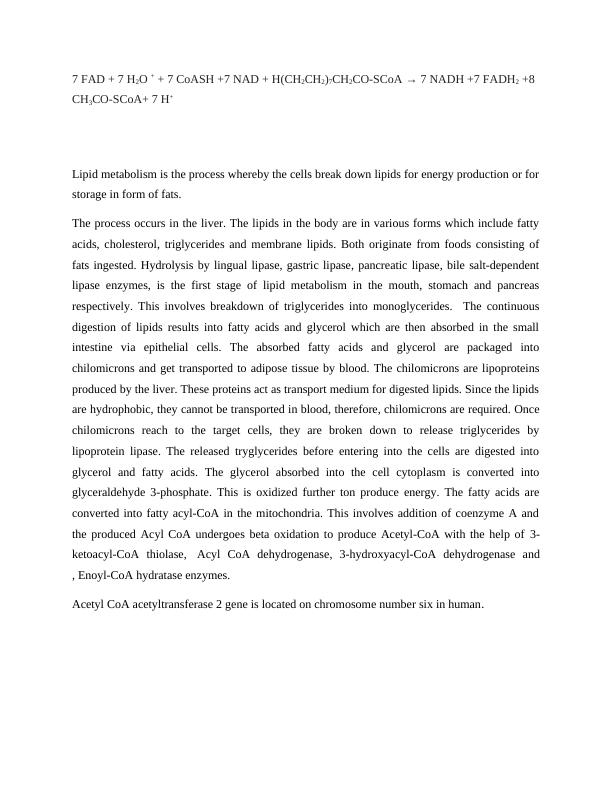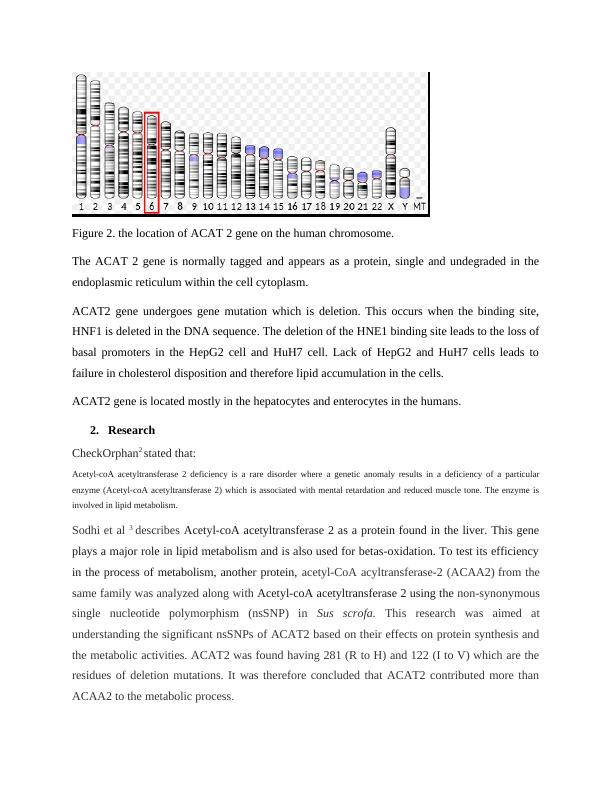Acetyl CoA Acetyltransferase 2 Deficiency: Overview, Research, Diagnosis, Treatment and Policy
Added on 2023-06-03
9 Pages2841 Words285 Views
Acetyl CoA acetyltransferase 2 deficiency.
1. An overview.
Acetyl CoA acetyltransferase 2 deficiency (ACAT2D) is a type of metabolic disorder. Metabolic
disorder is a condition where the metabolism process in the body fail to maintain essential
elements required for proper functioning of the body. Acetyl CoA acetyltransferase 2 deficiency
is therefore a condition whereby there is low levels of cytosolic acetoacetyl-CoA thiolase
(ACAT2) enzyme [EC:2.3.1.9]1(p 1) in the liver.
Cytosolic acetoacetyl-CoA thiolase is an enzyme coded by Acetyl CoA acetyltransferase 2 gene
(gene ID: 39) and it is used for lipid metabolization. This gene is found in both humans and
animals such as mouse.
Deficiency in Acetyl CoA acetyltransferase 2 leads to mental retardation which is expressed by
reduction in mental ability as well as low levels of intelligence. It also causes reduction of
muscle tone. This is characterized by loss of muscle tightness as well as reduction in the amount
of muscles.
Figure 1. Cytosolic acetoacetyl-CoA thiolase (ACAT2) enzyme used for lipid metabolization.
Biochemical pathway
The overall lipid metabolism by ACAT2 enzyme is as shown in the following chemical reaction
process:
1. An overview.
Acetyl CoA acetyltransferase 2 deficiency (ACAT2D) is a type of metabolic disorder. Metabolic
disorder is a condition where the metabolism process in the body fail to maintain essential
elements required for proper functioning of the body. Acetyl CoA acetyltransferase 2 deficiency
is therefore a condition whereby there is low levels of cytosolic acetoacetyl-CoA thiolase
(ACAT2) enzyme [EC:2.3.1.9]1(p 1) in the liver.
Cytosolic acetoacetyl-CoA thiolase is an enzyme coded by Acetyl CoA acetyltransferase 2 gene
(gene ID: 39) and it is used for lipid metabolization. This gene is found in both humans and
animals such as mouse.
Deficiency in Acetyl CoA acetyltransferase 2 leads to mental retardation which is expressed by
reduction in mental ability as well as low levels of intelligence. It also causes reduction of
muscle tone. This is characterized by loss of muscle tightness as well as reduction in the amount
of muscles.
Figure 1. Cytosolic acetoacetyl-CoA thiolase (ACAT2) enzyme used for lipid metabolization.
Biochemical pathway
The overall lipid metabolism by ACAT2 enzyme is as shown in the following chemical reaction
process:

7 FAD + 7 H2O + + 7 CoASH +7 NAD + H(CH2CH2)7CH2CO-SCoA → 7 NADH +7 FADH2 +8
CH3CO-SCoA+ 7 H+
Lipid metabolism is the process whereby the cells break down lipids for energy production or for
storage in form of fats.
The process occurs in the liver. The lipids in the body are in various forms which include fatty
acids, cholesterol, triglycerides and membrane lipids. Both originate from foods consisting of
fats ingested. Hydrolysis by lingual lipase, gastric lipase, pancreatic lipase, bile salt-dependent
lipase enzymes, is the first stage of lipid metabolism in the mouth, stomach and pancreas
respectively. This involves breakdown of triglycerides into monoglycerides. The continuous
digestion of lipids results into fatty acids and glycerol which are then absorbed in the small
intestine via epithelial cells. The absorbed fatty acids and glycerol are packaged into
chilomicrons and get transported to adipose tissue by blood. The chilomicrons are lipoproteins
produced by the liver. These proteins act as transport medium for digested lipids. Since the lipids
are hydrophobic, they cannot be transported in blood, therefore, chilomicrons are required. Once
chilomicrons reach to the target cells, they are broken down to release triglycerides by
lipoprotein lipase. The released tryglycerides before entering into the cells are digested into
glycerol and fatty acids. The glycerol absorbed into the cell cytoplasm is converted into
glyceraldehyde 3-phosphate. This is oxidized further ton produce energy. The fatty acids are
converted into fatty acyl-CoA in the mitochondria. This involves addition of coenzyme A and
the produced Acyl CoA undergoes beta oxidation to produce Acetyl-CoA with the help of 3-
ketoacyl-CoA thiolase, Acyl CoA dehydrogenase, 3-hydroxyacyl-CoA dehydrogenase and
, Enoyl-CoA hydratase enzymes.
Acetyl CoA acetyltransferase 2 gene is located on chromosome number six in human.
CH3CO-SCoA+ 7 H+
Lipid metabolism is the process whereby the cells break down lipids for energy production or for
storage in form of fats.
The process occurs in the liver. The lipids in the body are in various forms which include fatty
acids, cholesterol, triglycerides and membrane lipids. Both originate from foods consisting of
fats ingested. Hydrolysis by lingual lipase, gastric lipase, pancreatic lipase, bile salt-dependent
lipase enzymes, is the first stage of lipid metabolism in the mouth, stomach and pancreas
respectively. This involves breakdown of triglycerides into monoglycerides. The continuous
digestion of lipids results into fatty acids and glycerol which are then absorbed in the small
intestine via epithelial cells. The absorbed fatty acids and glycerol are packaged into
chilomicrons and get transported to adipose tissue by blood. The chilomicrons are lipoproteins
produced by the liver. These proteins act as transport medium for digested lipids. Since the lipids
are hydrophobic, they cannot be transported in blood, therefore, chilomicrons are required. Once
chilomicrons reach to the target cells, they are broken down to release triglycerides by
lipoprotein lipase. The released tryglycerides before entering into the cells are digested into
glycerol and fatty acids. The glycerol absorbed into the cell cytoplasm is converted into
glyceraldehyde 3-phosphate. This is oxidized further ton produce energy. The fatty acids are
converted into fatty acyl-CoA in the mitochondria. This involves addition of coenzyme A and
the produced Acyl CoA undergoes beta oxidation to produce Acetyl-CoA with the help of 3-
ketoacyl-CoA thiolase, Acyl CoA dehydrogenase, 3-hydroxyacyl-CoA dehydrogenase and
, Enoyl-CoA hydratase enzymes.
Acetyl CoA acetyltransferase 2 gene is located on chromosome number six in human.

Figure 2. the location of ACAT 2 gene on the human chromosome.
The ACAT 2 gene is normally tagged and appears as a protein, single and undegraded in the
endoplasmic reticulum within the cell cytoplasm.
ACAT2 gene undergoes gene mutation which is deletion. This occurs when the binding site,
HNF1 is deleted in the DNA sequence. The deletion of the HNE1 binding site leads to the loss of
basal promoters in the HepG2 cell and HuH7 cell. Lack of HepG2 and HuH7 cells leads to
failure in cholesterol disposition and therefore lipid accumulation in the cells.
ACAT2 gene is located mostly in the hepatocytes and enterocytes in the humans.
2. Research
CheckOrphan2 stated that:
Acetyl-coA acetyltransferase 2 deficiency is a rare disorder where a genetic anomaly results in a deficiency of a particular
enzyme (Acetyl-coA acetyltransferase 2) which is associated with mental retardation and reduced muscle tone. The enzyme is
involved in lipid metabolism.
Sodhi et al 3 describes Acetyl-coA acetyltransferase 2 as a protein found in the liver. This gene
plays a major role in lipid metabolism and is also used for betas-oxidation. To test its efficiency
in the process of metabolism, another protein, acetyl-CoA acyltransferase-2 (ACAA2) from the
same family was analyzed along with Acetyl-coA acetyltransferase 2 using the non-synonymous
single nucleotide polymorphism (nsSNP) in Sus scrofa. This research was aimed at
understanding the significant nsSNPs of ACAT2 based on their effects on protein synthesis and
the metabolic activities. ACAT2 was found having 281 (R to H) and 122 (I to V) which are the
residues of deletion mutations. It was therefore concluded that ACAT2 contributed more than
ACAA2 to the metabolic process.
The ACAT 2 gene is normally tagged and appears as a protein, single and undegraded in the
endoplasmic reticulum within the cell cytoplasm.
ACAT2 gene undergoes gene mutation which is deletion. This occurs when the binding site,
HNF1 is deleted in the DNA sequence. The deletion of the HNE1 binding site leads to the loss of
basal promoters in the HepG2 cell and HuH7 cell. Lack of HepG2 and HuH7 cells leads to
failure in cholesterol disposition and therefore lipid accumulation in the cells.
ACAT2 gene is located mostly in the hepatocytes and enterocytes in the humans.
2. Research
CheckOrphan2 stated that:
Acetyl-coA acetyltransferase 2 deficiency is a rare disorder where a genetic anomaly results in a deficiency of a particular
enzyme (Acetyl-coA acetyltransferase 2) which is associated with mental retardation and reduced muscle tone. The enzyme is
involved in lipid metabolism.
Sodhi et al 3 describes Acetyl-coA acetyltransferase 2 as a protein found in the liver. This gene
plays a major role in lipid metabolism and is also used for betas-oxidation. To test its efficiency
in the process of metabolism, another protein, acetyl-CoA acyltransferase-2 (ACAA2) from the
same family was analyzed along with Acetyl-coA acetyltransferase 2 using the non-synonymous
single nucleotide polymorphism (nsSNP) in Sus scrofa. This research was aimed at
understanding the significant nsSNPs of ACAT2 based on their effects on protein synthesis and
the metabolic activities. ACAT2 was found having 281 (R to H) and 122 (I to V) which are the
residues of deletion mutations. It was therefore concluded that ACAT2 contributed more than
ACAA2 to the metabolic process.

End of preview
Want to access all the pages? Upload your documents or become a member.
Related Documents
Chemistry and Biochemistry – BIOB111lg...
|11
|1544
|260
Evaluate Biological Functions of Categories of Macronutrientslg...
|4
|649
|24